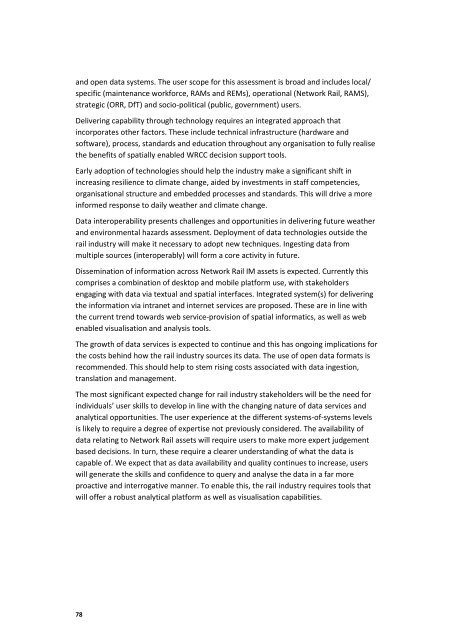Tomorrow's Railway and Climate Change Adaptation Final Report
2016-05-T1009-final-report
2016-05-T1009-final-report
Create successful ePaper yourself
Turn your PDF publications into a flip-book with our unique Google optimized e-Paper software.
<strong>and</strong> open data systems. The user scope for this assessment is broad <strong>and</strong> includes local/<br />
specific (maintenance workforce, RAMs <strong>and</strong> REMs), operational (Network Rail, RAMS),<br />
strategic (ORR, DfT) <strong>and</strong> socio-political (public, government) users.<br />
Delivering capability through technology requires an integrated approach that<br />
incorporates other factors. These include technical infrastructure (hardware <strong>and</strong><br />
software), process, st<strong>and</strong>ards <strong>and</strong> education throughout any organisation to fully realise<br />
the benefits of spatially enabled WRCC decision support tools.<br />
Early adoption of technologies should help the industry make a significant shift in<br />
increasing resilience to climate change, aided by investments in staff competencies,<br />
organisational structure <strong>and</strong> embedded processes <strong>and</strong> st<strong>and</strong>ards. This will drive a more<br />
informed response to daily weather <strong>and</strong> climate change.<br />
Data interoperability presents challenges <strong>and</strong> opportunities in delivering future weather<br />
<strong>and</strong> environmental hazards assessment. Deployment of data technologies outside the<br />
rail industry will make it necessary to adopt new techniques. Ingesting data from<br />
multiple sources (interoperably) will form a core activity in future.<br />
Dissemination of information across Network Rail IM assets is expected. Currently this<br />
comprises a combination of desktop <strong>and</strong> mobile platform use, with stakeholders<br />
engaging with data via textual <strong>and</strong> spatial interfaces. Integrated system(s) for delivering<br />
the information via intranet <strong>and</strong> internet services are proposed. These are in line with<br />
the current trend towards web service-provision of spatial informatics, as well as web<br />
enabled visualisation <strong>and</strong> analysis tools.<br />
The growth of data services is expected to continue <strong>and</strong> this has ongoing implications for<br />
the costs behind how the rail industry sources its data. The use of open data formats is<br />
recommended. This should help to stem rising costs associated with data ingestion,<br />
translation <strong>and</strong> management.<br />
The most significant expected change for rail industry stakeholders will be the need for<br />
individuals’ user skills to develop in line with the changing nature of data services <strong>and</strong><br />
analytical opportunities. The user experience at the different systems-of-systems levels<br />
is likely to require a degree of expertise not previously considered. The availability of<br />
data relating to Network Rail assets will require users to make more expert judgement<br />
based decisions. In turn, these require a clearer underst<strong>and</strong>ing of what the data is<br />
capable of. We expect that as data availability <strong>and</strong> quality continues to increase, users<br />
will generate the skills <strong>and</strong> confidence to query <strong>and</strong> analyse the data in a far more<br />
proactive <strong>and</strong> interrogative manner. To enable this, the rail industry requires tools that<br />
will offer a robust analytical platform as well as visualisation capabilities.<br />
78


